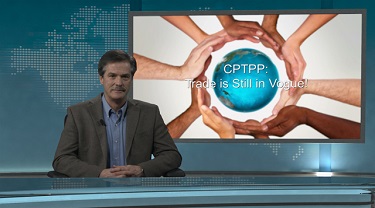A good night’s sleep doesn’t come easily for Canadian exporters these days. Export sales aren’t the issue; they are booming, thanks to the red-hot US economy. The big worry is that it’ll all come to a grinding halt. The threat of protectionism has zoomed up their insomnia list; they are keenly concerned about radical changes to the international trade superstructure, and how to prepare themselves. Are their fears founded?
Great question. Global support for the anti-trade movement intensified in the suddenness of the Great Recession, and the inability of the world economy to rack up respectable growth for the past seven years. Millions were unable to find meaningful work, or any work at all, sparkling a negative reaction toward government, corporations, post-war institutions and the ‘1-per-cent’. It’s a delicate dance: just as frustration is fomenting, the disaffected are returning to the job market in droves. Activism could lead to an undermining of the very architecture that at long last is serving up the very thing activists have been asking for.
Thankfully, to date anti-trade political bombast is just that. Last year’s volley of European elections all tilted toward traditional structures. The US keeps threatening to back away from trade agreements, most notably NAFTA, but in this case, it keeps coming back to the table with a modernization message.
Why is the CPTPP important to Canada?
Amid the mayhem, deals are still being done. Canada has inked CETA with Europe, and indications are that the Comprehensive and Progressive Agreement for Trans-Pacific Partnership (CPTPP) might indeed be signed this week. This new deal is exciting for a number of key reasons. First, it is dealing with intellectual property considerations in new ways. Next, it crafts new rules for trade in services, a burgeoning segment of the international trade space. Third, it is bringing together nations with very exciting growth stories and potential to continue that path for years to come. Fourth, the deal could have fizzled in the wake of American withdrawal, but it hasn’t. For Canada, it’s our first free-trade foray into Asia, aside from the deal with Korea. And it further expands – by over 13 per cent – the significant share of world GDP that Canada has access to through trade agreements.
Trade with Canada and CPTPP countries
What’s in it for Canada? About $100 billion in goods and services flowed between Canada and CPTPP countries in 2017 – enough that collectively, they are Canada’s third-largest trading partner. Net of Japan, merchandise exports to this bloc has grown by 6.6 per cent annually since 2000, over four times Canada’s average. More recently, it’s consistently double the overall growth of goods exports. Add to that the more sizable investment relationship with CPTPP countries - $122 billion in 2016 – and the picture of potential gets even better.
Lowering tariff barriers with the CPTPP countries yields considerable benefits. Economists at Global Affairs Canada estimate that a trade agreement will ultimately lift Canadian GDP by $4.2 billion, and exports by $2.7 billion. The bulk of the gains arise from tariff reductions, which are larger for other nations than for Canada. Interestingly, both the GDP and export gains are larger under CPTPP than under the original TPP agreement.
Not all sectors will benefit equally. Those with the larger gains include meat exports, with a net increase of greater than $1 billion. Exports of services see the next-highest impact, while the auto and wood products sectors are next. In the case of autos, there is concern about non-tariff barriers and cultural factors that may limit the ability to penetrate certain markets.
Given the general shift to a more anti-trade stance, it was a pleasant surprise to see revived interest in the CPTPP deal. It is giving liberalized trade and the process of globalization a very needed and timely shot in the arm. Hopefully it is timely enough to stave off the popular but misguided notion that gains from trade are an economic theorist’s illusion, one that has in general failed a vast chunk of the population. Thankfully, the economic cycle has stepped up to lend its support – the benefits are mounting, and are consistently grabbing the headlines.
The bottom line?
Sleep-stealing anti-trade politics isn’t likely to cease anytime soon. As long as it has mass appeal, it’ll be used as vote-getting rhetoric. So far, the ‘gains from trade’ logic is winning out. Inking the CPTPP deal will give the movement needed momentum – and for exporters, an angst antidote.





